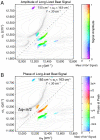Direct evidence of quantum transport in photosynthetic light-harvesting complexes
- PMID: 22167798
- PMCID: PMC3248508
- DOI: 10.1073/pnas.1105234108
Direct evidence of quantum transport in photosynthetic light-harvesting complexes
Abstract
The photosynthetic light-harvesting apparatus moves energy from absorbed photons to the reaction center with remarkable quantum efficiency. Recently, long-lived quantum coherence has been proposed to influence efficiency and robustness of photosynthetic energy transfer in light-harvesting antennae. The quantum aspect of these dynamics has generated great interest both because of the possibility for efficient long-range energy transfer and because biology is typically considered to operate entirely in the classical regime. Yet, experiments to date show only that coherence persists long enough that it can influence dynamics, but they have not directly shown that coherence does influence energy transfer. Here, we provide experimental evidence that interaction between the bacteriochlorophyll chromophores and the protein environment surrounding them not only prolongs quantum coherence, but also spawns reversible, oscillatory energy transfer among excited states. Using two-dimensional electronic spectroscopy, we observe oscillatory excited-state populations demonstrating that quantum transport of energy occurs in biological systems. The observed population oscillation suggests that these light-harvesting antennae trade energy reversibly between the protein and the chromophores. Resolving design principles evident in this biological antenna could provide inspiration for new solar energy applications.
Conflict of interest statement
The authors declare no conflict of interest.
Figures



References
-
- Forster T. Energiewanderung Und Fluoreszenz. (Energy Transfer and Fluorescence) Naturwissenschaften. 1946;33:166–175. (in German)
-
- Redfield AG. The theory of relaxation processes. In: Waugh JS, editor. Advances in Magnetic Resonance. Vol 1. New York: Academic; 1965.
-
- Zhang WM, Meier T, Chernyak V, Mukamel S. Exciton-migration and three-pulse femtosecond optical spectroscopies of photosynthetic antenna complexes. J Chem Phys. 1998;108:7763–7774.
-
- Yang MN, Fleming GR. Influence of phonons on exciton transfer dynamics: Comparison of the Redfield, Forster, and modified Redfield equations. Chem Phys. 2002;275:355–372.
-
- Engel GS, et al. Evidence for wavelike energy transfer through quantum coherence in photosynthetic systems. Nature. 2007;446:782–786. - PubMed
Publication types
MeSH terms
Substances
Grants and funding
LinkOut - more resources
Full Text Sources

